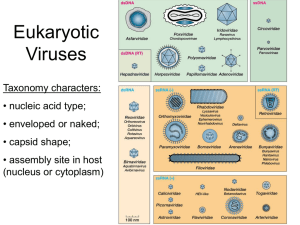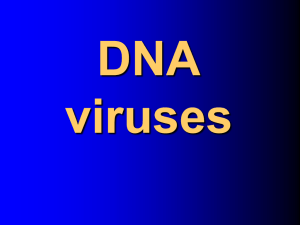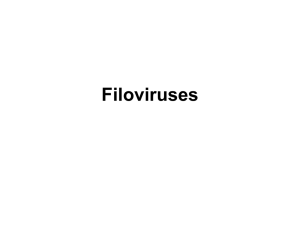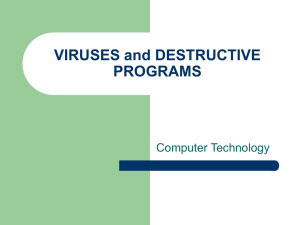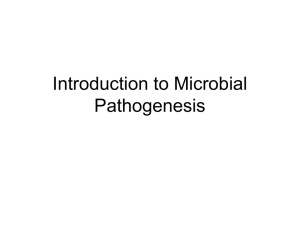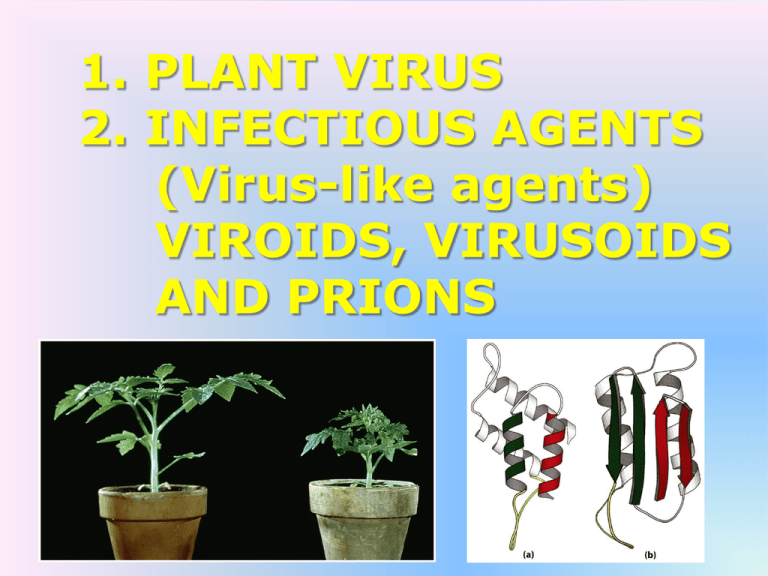
1. PLANT VIRUS
2. INFECTIOUS AGENTS
(Virus-like agents)
VIROIDS, VIRUSOIDS
AND PRIONS
LESSON OUTCOME
• Definition – viroids, virusoids and prions
• Explain these three
• Similarities and differentiation between these virus-like
agents
• Compare between virus and viroids/virusoids.
• Characteristics to compare prions, viroids and viruses
• Relationship between virus and cancer
Plant viruses
• Plant viruses face special problems initiating an infection.
- The outer surfaces of plants are composed of protective layers of
waxes and pectin, but more significantly, each cell is surrounded
by a thick wall of cellulose overlying the cytoplasmic membrane.
- no plant virus is known to use a specific cellular receptor of the
type that animal and bacterial viruses use to attach to cells.
- Plant viruses rely on a mechanical breach of the integrity of a
cell wall to directly introduce a virus particle into a cell. - - This is
achieved either by the vector associated with transmission of the
virus or simply by mechanical damage to cells.
Transmission Plant viruses
•
•
•
•
Through sap - entry
Seeds: due to external contamination of the seed with virus particles, or due to
infection of the living tissues of the embryo.
Vectors: Many different groups of living organisms can act as vectors and spread
viruses from one plant to another:
– Bacteria (e.g. Agrobacterium tumefaciens - the Ti plasmid of this organism has
been used experimentally to transmit virus genomes between plants)
– Fungi
– Nematodes
– Arthropods: Insects - aphids, leafhoppers, planthoppers, beetles, thrips, etc.
– Arachnids - mites
Mechanical: Mechanical transmission of viruses is the most widely used method for
experimental infection of plants and is usually achieved by rubbing virus-containing
preparations into the leaves, which in most plant species are particularly susceptible to
infection. However, this is also an important natural method of transmission. Virus
particles may contaminate soil for long periods and may be transmitted to the leaves
of new host plants as wind-blown dust or as rain-splashed mud.
Plant viruses: example
RNA Viruses - Class IV (+ sense)
Family Potyviridae
(Genus Potyvirus) - potato virus Y
- papaya ringspot virus (PRSV)
Flexiviridae - potato virus X
Comoviridae- cowpea mosaic virus
Genus Tobamovirus- tobacco mosaic virus
Family: Sequiviridae - Plant virus
Genus: Waikavirus – rice tungro spherical virus
ssRNA
INFECTOUS AGENTS
• Virion
= a complete virus particle, including envelope (if
any)
OTHER THAN VIRUS : IN PLANT
• Viroid = an infectious RNA particle, smaller than a virus,
lacking a capsid, that causes various plant diseases
- depend on virus to replicate, its nucleotide
only encode structural proteins
• Virusoid (satellite nucleic acids) = same as viroid; small,
ssRNA molecule, usually 500 to 2000 nucleotides in length,
lacking a capsid, lack genes required for the replication
virusoid require a helper (satellite) virus to replicate, causes
various plant diseases.
SIMILARITIES
Viroid
Virusoid
Nucleic acid – ssRNA
Lack capsid, cause plant diseases
DIFFERENCES
Viroids
Virusoids
1. Does not require helper virus
1. Require helper virus for
replication
2. Does not encode protein
2. Encode proteins
3. Replication takes place in host
cell nucleus
3. Replication takes place in host’s
cytoplasm
Animal virusoid = hepatitis delta virusoid –
the helper virus is Hepatitis B virus.
Example
Avsunviroidae, two known members
are the avocado sunblotch viroid and
the peach latent mosaic viroid.
The potato spindle tuber
viroid and tomato plant
macho viroid, members
of the family
Pospiviroidae,
Viroid
- avocado sunblotch viroid, peach latent mosaic, potato spindle tuber,
coconut cadang-cadang, tomato plant macho viroid, citrus bent leaf viroid,
pear blister canker viroid
-Virusoid
- barley yellow dwarf satellite RNA , tobacco ringspot virus satellite RNA
Disease
Viroid - cause lethal plant diseases; potato spindle tuber disease,
chrysanthemum stunt disease, cucumber pale fruit disease, coconut
cadang-cadang disease, chrysanthemum stunt disease, tomato apical stunt
disease.
Virusoid - cause tobacco necrosis
PRIONS
• A unique infectious agent, protein infectious particle
• Prion = a small infectious particle consisting of protein and lack
nucleic acid.
• Prion – features:
- Resistant to inactivation by heating to 90o C, which
inactivate virus
- The infection is not sensitive to radiation; radiation damages
virus genomes
- Prions are not destroyed by enzymes that digest nucleic acids
- Sensitive to protein denaturing agents; urea, phenol
- Prions have direct pairing of amino acids
• Diseases –
PRIONS
1. Creutzfeldt-Jakob – mental degeneration, loss of motor
function and death (human)
Mad – cow disease
2. Scrapie and bovine spongiform encephalopathy (BSE) –
loss of neuronal function that leads to death in sheep and
dairy cattle.
3. Kuru – a neurological disorder in human Holes brain –
“spongiform”
Cerebral cortex of a normal human
brain (right), patient with CJD (left).
Once present in the brain, prions cause normal proteins to refold into abnormal shapes. As these
abnormal proteins multiply, they destroy neurons and eventually cause brain tissue to become
riddled with holes. Prions can only be destroyed through incineration.
Viruses, Viroids and Prions
Characteristic between virus, viroid and prion
Nucleic acid type, NA strandedness, host range and structural features
Virus and Cancer
VIRUS AND CANCER INTRODUCTION
• Cancers are the result of a disruption of the normal restraints on cellular
proliferation. It is apparent that the number of ways in which such disruption can
occur is strictly limited and there may be as few as forty cellular genes in which
mutation or some other disruption of their expression leads to unrestrained cell
growth.
• There are two classes of these genes in which altered expression can lead to loss
of growth control:
(a) Those genes that are stimulatory for growth and which cause cancer when
hyperactive. Mutations in these genes will be dominant. These genes are called
oncogenes.
(b) Those genes that inhibit cell growth and which cause cancer when they are
turned off. Mutations in these genes will be recessive. These are the anti-oncogenes
or tumor-suppressor genes.
• Viruses are involved in cancers because they can either carry a copy of one of these
genes or can alter expression of the cell's copy of one of these genes. – tumor
viruses
REMEMBER: Animal virus
Not all virus infection will cause immediate lysis to
host cell Virulent virus
-
- some maintain a carrier relationship, these so called
persistent infections can last from a few weeks to the
remainder of the host’s life. Latency/latent state
- Example: measles virus, herpes simplex viruses
(cold sores and genital herpes) and herpes zoster
virus (chicken pox and shingles).
Viruses and Cancer
Some
animal viruses enter their host cell and permanently alter its
genetic material, leading to cancer.
A process when virus catalyze
These viruses are termed oncogenic,
the conversion of a normal cell to
a tumor cell.
Their effect on the cell is called transformation.
- A startling feature of these viruses is that their nucleic acid is
consolidated into the host DNA.
- Transformed cells have an increased rate of growth; alterations
in chromosomes; changes in the cell’s surface molecules; and the
capacity to divide for an indefinite period, unlike normal animal
cells.
Mammalian viruses capable of initiating tumors are called
oncoviruses.
DNA viruses such as papillomavirus (genital warts are associated
with cervical cancer), herpesviruses (Epstein-Barr virus causes
Burkitt’s lymphoma), and hepatitis B virus.
Latent state
Related with tumor
formation – eventually
producing cancerous cell
TUMOR VIRUSES
CLASSES OF TUMOR VIRUSES
• There are two classes of tumor viruses:
1. DNA tumor viruses
2. RNA tumor viruses, the latter also being referred to as
RETROVIRUSES.
• These two classes have very different ways of reproducing
themselves but they often have one aspect of their life cycle in
common: the ability to integrate their own genome into that of the
host cell. Such integration is not, however, a pre-requisite for tumor
formation.
How viruses cause cancer
- DNA tumor viruses – can exist as
provirus
- RNA tumor viruses – use own RTase
to transcribe (+) sense RNA into
DNA that integrates as provirus
- Cancer is due to unregulated viral
proteins in cell causing the host cells
to divide uncontrollably. Some viral
proteins blocks the tumor-suppressor
genes (prevent uncontrolled cell
divisions) therefore a tumor
develops.
18
Viruses and Cancer
• Oncogenes = gene that when mutated and expressed at
high level will form tumor due to uncontrolled host cell
Oncogene = a gene that can bring about
divison
malignant transformation
- In DNA tumor virus, oncogenes also contain the
information for synthesizing viral proteins for viral
replication
• Proto-oncogenes = normal gene (from normal host
cells), that under the control of a virus can cause
uncontrolled cell division; can act as oncogene. The
oncogenes are not needed for virus replication.
19
VIRUS AND CANCER
Examples of viruses that are associated with human
cancers:
1. Epstein-Barr virus (EBV)
2. Human papillomavirus (HPV)
3. Hepatitis B virus (HBV)
EBV
What is the Epstein-Barr virus? Human herpesvirus 4 (HHV4),
• Herpesviridae – so dsDNA linear virus, icosahedral capsid and
has envelope
• EBV is a member of the herpesvirus family and causes more than
90% of cases of mononucleosis. EBV is a double-stranded DNA
virus named for the English virologists professor Sir Anthony
Epstein and Yvonne M. Barr.
• The designation "mononucleosis" refers to an increase in a special
type of white blood cells
(lymphocytes) in the bloodstream
relative to the other blood
components as a result of the EBV
infection.
EBV
• Mono is usually spread by person-to-person
contact with saliva as the primary method of transmission.
• person with mono can also pass on the disease by coughing or
sneezing, causing small droplets of infected saliva and/or mucus to be
suspended in the air and inhaled by others. Sharing food or beverages
from the same container or utensil can also transfer the virus from one
person to another, since contact with infected saliva may result.
EBV
• The initial symptoms of mono are a general
lack of energy (malaise), loss of appetite, and chills. The more common intense
symptoms include a severe sore throat, fever, and swollen glands (lymph nodes)
in the neck area. It is typically the severe sore throat that prompts people to
contact their doctor.– have recovered will continue to secrete the EBV in their
saliva for years due to periodic "reactivations" of the viral infection.
EBV
• This disease rarely fatal in healthy man, Mono tends to be more
aggressive in patients with abnormal immune systems, such as people
with AIDS or those who are taking medications that suppress immune
function. The EBV has been associated with some types of cancers,
most commonly lymphomas. As well, some studies have linked EBV to
the development of at least one subtype of Hodgkin's disease.
Burkitt’s Lymphoma - caused by Epstein-Barr Virus 2
• In 1958 he reported that the jaw tumours affected children between the
ages of two and fourteen years, with a peak incidence occurring at five
years. What became known as Burkitt’s lymphoma (BL) was found to
occur in a band across tropical Africa, tailing partly down the east coast,
and showing a similar distribution to holoendemic malaria. Also cause
Nasopharyngeal Carcinoma
Human papillomavirus
• Non-enveloped ds DNA virus
• Family Papillomaviridae
• HPV has vaccine
• Spread through epithelial – skin contact
• Some cause only benign warts.
• HPV-cause of cervical cancer, genital warts.
HPVs may play a role in some cancers of the anus,
vulva, vagina, and penile cancer (cancer of the
penis) – eg. HPV-8 and HPV-16.


